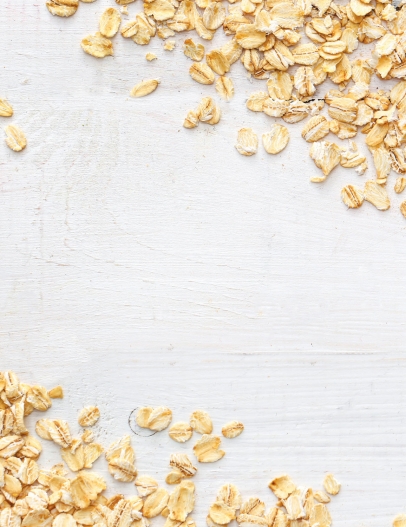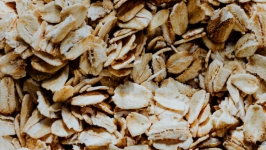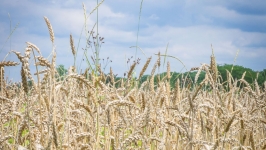Great Grains - Oats provide a warm and hearty dose of nutrition
On a chilly morning, nothing is quite as comforting as a warm bowl of oatmeal. Oats are a simple grain, easy to prepare and easily dressed up with healthy toppings. Oats may seem humble, but lots of care and attention go into their production.
Oats are sown in the spring and ready for harvest in late July, but may factors contribute to a successful crop.
“It’s a bit of a waiting game growing oats,” says Scott Morgan of Morganics Family Farm in Hillsborough. Oat farmers must wait until the grain has finished maturing and is dry enough to be run through the combine. “If you wait too long, the grain will literally fall off the plant and be wasted. If it’s not done drying, it can be too wet and grow mold,” he says. “The end of season is kind of a gamble—you’re hoping to get the right window of opportunity.”
Morgan harvests his oats when they’re between 13% and 14% moisture. The oats are then run through a combine, which is the primary harvesting tool. This is the first cleaning stage.
“It cuts the grain from the plant and beats it up inside the machine, removing the straw and chaff, and then the grains get collected in a big hopper,” he explains.
The next step is the air screen, which further removes anything that isn’t oats. Finally, the oats go through a Carter disc separator, a machine with metal discs and pockets specifically sized to match the size and length of the oats.
“The pockets are perfectly sized, and afterwards, all that’s left is good, clean oats.”
Oats in their whole form are called groats. “It cooks like a whole grain and looks like plump brown rice,” he says. “Rolled oats—or oatmeal—is made by using a mill, which is essentially two big steel wheels that are set really close together and presses and flattens the grains into oats.”
The oats produced by Morganics Farm are fresh, with a shelf life of four to six weeks. Commercial oats have a shelf life of up to a year because they are heated twice, which, according to Morgan, affects their taste and nutrition. Cold-pressed oats have a bright, sweet and nutty flavor, whereas commercial oats have been processed and rid of some qualities that affect their flavor.
“Many commercial brands steam their oats first and polish it to remove the bran, which is then sold back to consumers as oat bran. Steaming the oats [helps] make the pieces uniform. After, they roast the oats to add flavor, but this actually kills the beneficial enzymes, which, along with the oils and the germ, are very nutritious parts of the grain.”
Morgan explains that the less processed the grain, the better.
“Steel-cut oats are the next least processed because they are oats that have been chipped into three to four pieces. They are more intact, and they’ve been exposed to less oxidation, whereas rolled oats have been flattened and the whole grain is exposed to air.”
Oats offer relief to the digestive system and are rich in energy-boosting B vitamins.
Morgan notes that on the tip of every oat grain is a tiny, almost fiberglass-like hair called a trichome. During harvest, they become airborne.
“It creates such an itchy and irritating dust,” says Morgan. “It always amazes me how the end product is something that’s actually used for calming the skin.”
In fact, the thought of an oatmeal bath may bring back memories to those who have suffered from chicken pox.
“Oats have soothing, anti-itch effects as well as antioxidant and anti-inflammatory properties,” says Rena Zelig, Assistant Professor and Director of the Masters of Science program of Clinical Nutrition at Rutgers School of Health Professions in Newark. “Colloidal oatmeal, which are oats that have been finely ground up, is actually FDA approved as a skin-protective substance. “
Not only are oats soothing to the skin, they also offer relief to the digestive system.
“One major benefit of oats is that they are high in both soluble and insoluble fiber,” she says. “Insoluble fiber helps add bulk to the stool, which is good for promoting digestion and GI health. Soluble fiber attracts water, which helps give the food you’re digesting more of a gel-like consistency, making it take longer to move through the digestive tract, Zelig explains. “The longer food sits in the stomach, the more it improves satiety, keeping you feeling fuller longer.”
Zelig adds that soluble fiber also makes glucose release slower, which provides a more favorable glycemic response. (Candy and other sugary foods, on the other hand, are broken down quickly in the body, leading to unfavorable spikes in blood sugar.) In fact, Zelig warns against flavored packaged oatmeal, which tends to be high in sugar.
A hearty bowl of oats keeps you full in more ways than one.
“Oats contain a type of soluble fiber called beta glucan, which has not only been specifically linked to lowering LDL (‘bad’) cholesterol, it has [also] been shown to promote the release of a peptide called YY, which is linked to the satiety hormone,” says Zelig.
Along with lowering cholesterol, oats also help with overall heart health.
“Oats contain avenanthramides, a type of polyphenol with antioxidant properties that have been shown to increase nitric oxide production, which helps dilate blood vessels, leading to better blood flow.”
Along with this and their ability to sustain energy, oats offer an additional benefit to an active lifestyle.
“Oats are rich in energy-boosting B vitamins like thiamin (B1), riboflavin (B2), niacin (B3) and folate (B6),” Zelig says, adding that many commercial brands fortify their products, making them higher in vitamins already present in oats, like iron, magnesium, phosphorous, zinc, copper, manganese, potassium and calcium.
So if you’re looking for some sustaining energy to fuel you through the impending snow-shoveling season, turn to oats, a humble grain with a multitude of benefits.










